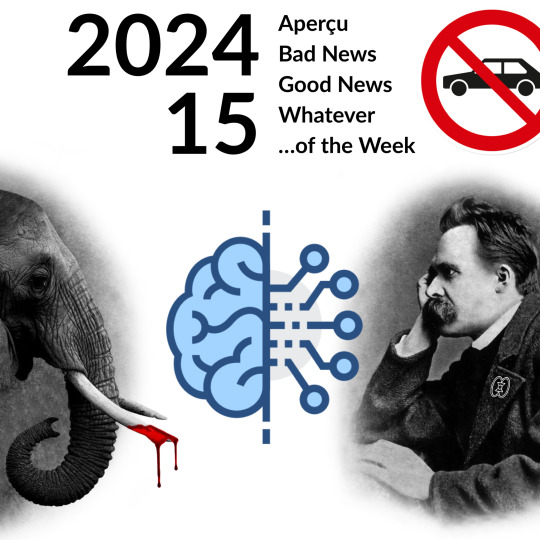#a star algorithm in artificial intelligence
Explore tagged Tumblr posts
Text
I Sacrificed My Writing To A.I So You Don't Have To
I was thinking about how people often say "Oh, Chat GPT can't write stories, but it can help you edit things!" I am staunchly anti-A.I, and I've never agreed with this position. But I wouldn't have much integrity to stand on if I didn't see for myself how this "editing" worked. So, I sacrificed part of a monologue from one of my fanfictions to Chat GPT to see what it had to say. Here is the initial query I made:

Chat GPT then gave me a list of revisions to make, most of which would be solved if it was a human and had read the preceding 150k words of story. I won't bore you with the list it made. I don't have to, as it incorporated those revisions into the monologue and gave me an edited sample back. Here is what it said I should turn the monologue into:

The revision erases speech patterns. Ben/the General speaks in stilted, short sentences in the original monologue because he is distinctly uncomfortable—only moving into longer, more complex structures when he is either caught up in an idea or struggling to elaborate on an idea. The Chat GPT version wants me to write dialogue like regular narrative prose, something that you'd use to describe a room. It also nullified the concept of theme. "A purity that implied personhood" simply says the quiet(ish) part out loud, literally in dialogue. It erases subtlety and erases how people actually talk in favor of more obvious prose. Then I got a terrible idea. What if I kept running the monologue through the algorithm? Feeding it its own revised versions over and over, like a demented Google Translate until it just became gibberish? So that's what I did. Surprisingly enough, from original writing sample to the end, it only took six turnarounds until it pretty much stopped altering the monologue. This was the final result:

This piece of writing is florid, overly descriptive, unnatural, and unsubtle. It makes the speaking character literally give voice to the themes through his dialogue, erasing all chances at subtext and subtlety. It uses unnecessary descriptors ("Once innocuous," "gleaming," "receded like a fading echo," "someone worth acknowledging,") and can't comprehend implication—because it is an algorithm, not a human that processes thoughts. The resulting writing is bland, stupid, lacks depth, and seemingly uses large words for large word's sake, not because it actually triggers an emotion in the reader or furthers the reader's understanding of the protagonist's mindset.
There you have it. Chat GPT, on top of being an algorithm run by callous, cruel people that steals artist's work and trains on it without compensation or permission, is also a terrible editor. Don't use it to edit, because it will quite literally make your writing worse. It erases authorial intention and replaces it with machine-generated generic slop. It is ridiculous that given the writer's strike right now, studios truly believe they can use A.I to produce a story of marginal quality that someone may pay to see. The belief that A.I can generate art is an insult to the writing profession and artists as a whole—I speak as a visual artist as well. I wouldn't trust Chat GPT to critique a cover letter, much less a novel or poem.
#fanfiction#writing#chatgpt#ai#aiwriting#artificial intelligence#fanfic#fanfic meta#artificially generated#writers on tumblr#writer problems#cryptobros#if these people ever took one humanities class they'd see the issues with these algorithms#anti chat gpt#anti capitalism#anti ai#don't use chat gpt to edit your work for the love of god#ai can't write#ao3#star wars fanfiction meta#wga strike#support the writers!#wga solidarity
117 notes
·
View notes
Text

2024 / 15
Aperçu of the Week
"Artificial intelligence will have a more profound impact on humanity than fire, electricity and the internet."
(Sundar Pichai, CEO of Alphabet aka Google)
Bad News of the Week
Artificial intelligence has the potential to be a Sith lord. So on the dark side of the force. Artificial intelligence existed long before the term was coined. After all, it's nothing more than YouTube suggesting another clip similar to the one you've just watched. Since then, algorithms have accompanied us everywhere in life where probability calculation plays a role. Social media has always done nothing different when it presents certain suggestions based on personal likes and followed channels and not alternatives - because the algorithm calculates that we would like result A better than result B (this is called a bubble). This is why we all initially had the feeling that the internet was mainly made up of conspiracy theories.
As with any fundamental innovation, there is potential for good and bad. The US doesn't give a shit about the good dominating. They don't seem to care at all that someone could and should care about a leadership function that this potential benefits the population as a whole. Instead, the usual priority dominates - the buck rules. A look at the country's political personnel reveals why: there are more millionaires than non-millionaires in both chambers of Congress. What might be the reason for this...
Artificial intelligence will not be stopped. It is up to the people - in the USA primarily those who decide and provide - whether this powerful tool will be dangerous or useful. It's like a kitchen knife: you can cook dinner for your family or stab someone with it. In a society that is primarily geared towards maximizing profits, it is to be feared that AI will primarily be used to replace working people. Because AI never gets sick, never goes on vacation or to the bathroom and can work 24/7. When it comes to earning money, its triumphal march is unstoppable. But it will also have many human victims.
Good News of the Week
Artificial intelligence has the potential to be a Jedi knight. So on the bright side of the force. Artificial intelligence existed long before the term was coined. After all, it's no different when a washing machine recognizes that it's only half full and therefore uses less water. Since then, algorithms have accompanied us everywhere in life where probability calculation plays a role. Internet search engines have always done nothing different when they prioritize certain results over others based on personal surfing behavior - because the algorithm calculates that we would like result A better than result B. This is why we all had the feeling at the beginning that the internet consisted mainly of cat videos.
As with any fundamental innovation, there is potential for good and bad. Europe is trying to ensure that the good dominates. The European Union is also trying to establish regulatory guard rails in this market. Of course, technological development is faster than its administrative management by the public sector. But it is coming. Sooner or later. And it is already costing US companies billions - with the exception of TikTok, all the major players come from the Pacific coast of the USA. Because we insist on compliance with the rules of the game. And we can enforce them, because our market is too big and attractive to be ignored. Without the EU, Meta, for example, would not have a single employee on the lookout for fake news.
Artificial intelligence will not be stopped. It is up to the people - in Europe primarily those who use it and allow themselves to be used - whether this powerful tool will be dangerous or useful. It's like a hammer: you can use it to hammer a nail into the wall for a picture or to beat someone to death. In a society that sees itself as a social community, it is at least the hope that routine activities will be automated with AI so that human labor can be used for more complex services. So when it comes to unleashing potential, its triumphal march is unstoppable. So it really will bring added value for people.
Personal happy moment of the week
This week, some good political news is also my personal happy moment: for the first time, climate activists, in this case Swiss senior citizens, have been successful with a lawsuit for stricter measures against climate change before the European Court of Human Rights (ECtHR). According to the judges, Switzerland had violated the applicants' human rights. The authorities had not acted in time and had not adequately addressed climate change and its consequences.
A ruling that will have a signal effect. After all, legal liability for "failure to provide assistance" - because that's what it is when politicians do too little to combat climate change - is likely to have a greater impact than demonstrations by committed citizens who are probably already acting sustainably anyway. Bravo.
I couldn't care less...
...that O. J. Simpson died. May he rest wherever he belongs.
It's fine with me...
...that US President Joe Biden is considering a "waiver of further prosecution" of whistleblower Julian Assange. I don't like the Wikileaks founder - it's not just in relation to the Swedish sex abuse allegations that there is usually at least a little fire where there is smoke. But he has shown us the necessity of taking responsibility even where authorities like to hide behind non-disclosure agreements and secrecy rules. There is now a "whistleblower protection law" throughout the European Union. Without Assange, this would not exist.
As I write this...
...I am trying to come to terms with the fact that FC Bayern Munich will not be German soccer champions for the first time in 11 years (!). "Vicekusen" is history, as Bayer Leverkusen's victory on Sunday puts them unassailably ahead and they can celebrate their championship five matchdays before the end of the season. And Munich even have to worry about finishing at second place, as Stuttgart are level on points in the table. There are still five days left in the season - and, after a long time, a lively competition again. That's actually a good thing. But it still hurts a little.
Post Scriptum
Germany has a climate protection law. It has defined targets for reducing climate-damaging emissions, for example, in order to (yes, we still have to hope for it) keep global warming under control. The targets apply according to the respective thematic responsibility of the ministries, i.e. the corresponding savings in the transport sector are the responsibility of the Ministry of Transport. The current legal text stipulates that the respective ministry must take effective immediate measures if it is foreseeable that targets will not be met. This is the case with transport, not least because the ministers (not only in this legislative period) lack ambition, to put it mildly.
The current Minister of Transport, Volker Wissing of the Liberals, has been nagging about the law for some time now and would like to be able to continue to remain unambitious by allowing ministries to offset against each other. In other words, he wants to have his own deficits compensated by others. He just can't get a majority for that. And is now starting to threaten, there's no other way to put it. If the law doesn't change, he would have to order "comprehensive and indefinite driving bans". For all private vehicles, on all Saturdays and Sundays. I assume that electric cars (we're already driving our third) would be exempt, but that's only a small percentage anyway. The targets could not be achieved with milder measures such as a speed limit, which he has of course never tried.
The outcry from Germany as a nation of motorists was and is huge. Which was certainly exactly what he had intended. However, almost all of the political competition and political commentators are not crying out against the evil law, but against his plan. There is talk of a "political indictment". And that it is irresponsible to "stir up unfounded fears". The Liberals are currently polling below 5% nationwide, meaning they would no longer make it into parliament. If they carry on like this, that won't change. What would be their own fault.
#thoughts#aperçu#good news#bad news#news of the week#happy moments#politics#sundar pichai#ai#artificial intelligence#internet#good and evil#algorithm#innovation#humans#workforce#star wars#human rights#climate change#oj simpson#julian assange#whistleblower#fc bayern#germany#protection#transportation#cars#soccer#wikileaks#switzerland
0 notes
Text
Artificial Intelligence at Humber College - Final Presentation
youtube
#portfolio#AI#artificial intelligence#steering behavior#steering behaviour#decision making#decision-making#decisionmaking#pathfinding#path finding#path-finding#A star#A-star#Dijkstra algorithm#breadth-first search#breadth first search#BFS#c++#computer programming#coding#code#programming#data structures
0 notes
Text
There is no such thing as AI.
How to help the non technical and less online people in your life navigate the latest techbro grift.
I've seen other people say stuff to this effect but it's worth reiterating. Today in class, my professor was talking about a news article where a celebrity's likeness was used in an ai image without their permission. Then she mentioned a guest lecture about how AI is going to help finance professionals. Then I pointed out, those two things aren't really related.
The term AI is being used to obfuscate details about multiple semi-related technologies.
Traditionally in sci-fi, AI means artificial general intelligence like Data from star trek, or the terminator. This, I shouldn't need to say, doesn't exist. Techbros use the term AI to trick investors into funding their projects. It's largely a grift.
What is the term AI being used to obfuscate?
If you want to help the less online and less tech literate people in your life navigate the hype around AI, the best way to do it is to encourage them to change their language around AI topics.
By calling these technologies what they really are, and encouraging the people around us to know the real names, we can help lift the veil, kill the hype, and keep people safe from scams. Here are some starting points, which I am just pulling from Wikipedia. I'd highly encourage you to do your own research.
Machine learning (ML): is an umbrella term for solving problems for which development of algorithms by human programmers would be cost-prohibitive, and instead the problems are solved by helping machines "discover" their "own" algorithms, without needing to be explicitly told what to do by any human-developed algorithms. (This is the basis of most technologically people call AI)
Language model: (LM or LLM) is a probabilistic model of a natural language that can generate probabilities of a series of words, based on text corpora in one or multiple languages it was trained on. (This would be your ChatGPT.)
Generative adversarial network (GAN): is a class of machine learning framework and a prominent framework for approaching generative AI. In a GAN, two neural networks contest with each other in the form of a zero-sum game, where one agent's gain is another agent's loss. (This is the source of some AI images and deepfakes.)
Diffusion Models: Models that generate the probability distribution of a given dataset. In image generation, a neural network is trained to denoise images with added gaussian noise by learning to remove the noise. After the training is complete, it can then be used for image generation by starting with a random noise image and denoise that. (This is the more common technology behind AI images, including Dall-E and Stable Diffusion. I added this one to the post after as it was brought to my attention it is now more common than GANs.)
I know these terms are more technical, but they are also more accurate, and they can easily be explained in a way non-technical people can understand. The grifters are using language to give this technology its power, so we can use language to take it's power away and let people see it for what it really is.
12K notes
·
View notes
Text
Gandersauce

I'm on a 20+ city book tour for<p>placehold://://er </p> my new novel PICKS AND SHOVELS. Catch me in AUSTIN on MONDAY (Mar 10). I'm also appearing at SXSW and at many events around town, for Creative Commons and Fediverse House. More tour dates here.

It's true that capitalists by and large hate capitalism – given their druthers, entrepreneurs would like to attain a perch from which they get to set prices and wages and need not fear competitors. A market where everything is up for grabs is great – if you're the one doing the grabbing. Less so if you're the one whose profits, customers and workers are being grabbed at.
But while all capitalists hate all capitalism, a specific subset of capitalists really, really hate a specific kind of capitalism. The capitalists who hate capitalism the most are Big Tech bosses, and the capitalism they hate the most is techno-capitalism. Specifically, the techno-capitalism of the first decade of this century – the move fast/break things capitalism, the beg forgiveness, not permission capitalism, the blitzscaling capitalism.
The capitalism tech bosses hate most of all is disruptive capitalism, where a single technological intervention, often made by low-resourced individuals or small groups, can upend whole industries. That kind of disruption is only fun when you're the disruptor, but it's no fun for the disruptees.
Jeff Bezos's founding mantra for Amazon was "your margin is my opportunity." This is a classic disruption story: I'm willing to take a smaller profit than the established players in the industry. My lower prices will let me poach their customers, so I grow quickly and find more opportunities to cut margins but make it up in volume. Bezos described this as a flywheel that would spin faster and faster, rolling up more and more industries. It worked!
https://techcrunch.com/2016/09/10/at-amazon-the-flywheel-effect-drives-innovation/
The point of that flywheel wasn't the low prices, of course. Amazon is a paperclip-maximizing artificial intelligence, and the paperclip it wants to maximize is profits, and the path to maximum profits is to charge infinity dollars for things that cost you zero dollars. Infinite prices and nonexistent wages are Amazon's twin pole-stars. Amazon warehouse workers don't have to be injured at three times the industry average, but maiming workers is cheaper than keeping them in good health. Once Amazon vanquished its competitors and captured the majority of US consumers, it raised prices, and used its market dominance to force everyone else to raise their prices, too. Call it "bezosflation":
https://pluralistic.net/2023/04/25/greedflation/#commissar-bezos
We could disrupt Amazon in lots of ways. We could scrape all of Amazon's "ASIN" identifiers and make browser plugins that let local sellers advertise when they have stock of the things you're about to buy on Amazon:
https://pluralistic.net/2022/07/10/view-a-sku/
We could hack the apps that monitor Amazon drivers, from their maneuvers to their eyeballs, so drivers had more autonomy and their bosses couldn't punish them for prioritizing their health and economic wellbeing over Amazon's. An Amazon delivery app mod could even let drivers earn extra money by delivering for Amazon's rivals while they're on their routes:
https://pluralistic.net/2023/04/12/algorithmic-wage-discrimination/#fishers-of-men
We could sell Amazon customers virtual PVRs that let them record and keep the shows they like, which would make it easier to quit Prime, and would kill Amazon's sleazy trick of making all the Christmas movies into extra-cost upsells from November to January:
https://www.amazonforum.com/s/question/0D54P00007nmv9XSAQ/why-arent-all-the-christmas-movies-available-through-prime-its-a-pandemic-we-are-stuck-at-home-please-add-the-oldies-but-goodies-to-prime
Rival audiobook stores could sell jailbreaking kits for Audible subscribers who want to move over to a competing audiobook platform, stripping Amazon's DRM off all their purchases and converting the files to play on a non-Amazon app:
https://pluralistic.net/2022/07/25/can-you-hear-me-now/#acx-ripoff
Jeff Bezos's margin could be someone else's opportunity…in theory. But Amazon has cloaked itself – and its apps and offerings – in "digital rights management" wrappers, which cannot be removed or tampered with under pain of huge fines and imprisonment:
https://locusmag.com/2020/09/cory-doctorow-ip/
Amazon loves to disrupt, talking a big game about "free markets and personal liberties" – but let someone attempt to do unto Amazon as Amazon did unto its forebears, and the company will go running to Big Government for a legal bailout, asking the state to enforce its business model:
https://apnews.com/article/washington-post-bezos-opinion-trump-market-liberty-97a7d8113d670ec6e643525fdf9f06de
You'll find this cowardice up and down the tech stack, wherever you look. Apple launched the App Store and the iTunes Store with all kinds of rhetoric about how markets – paying for things, rather than getting them free through ads – would correct the "market distortions." Markets, we were told, would produce superior allocations, thanks to price and demand signals being conveyed through the exchange of money for goods and services.
But Apple will not allow itself to be exposed to market forces. They won't even let independent repair shops compete with their centrally planned, monopoly service programs:
https://pluralistic.net/2022/05/22/apples-cement-overshoes/
Much less allow competitors to create rival app stores that compete for users and apps:
https://pluralistic.net/2024/02/06/spoil-the-bunch/#dma
They won't even refurbishers re-sell parts from phones and laptops that are beyond repair:
https://www.shacknews.com/article/108049/apple-repair-critic-louis-rossmann-takes-on-us-customs-counterfeit-battery-seizure
And they take the position that if you do manage to acquire a donor part from a dead phone or laptop, that it is a felony – under the same DRM laws that keep Amazon's racket intact – to install them in a busted device:
https://www.theverge.com/2024/3/27/24097042/right-to-repair-law-oregon-sb1596-parts-pairing-tina-kotek-signed
"Rip, mix, burn" is great when it's Apple doing the ripping, mixing and burning, but let anyone attempt to return the favor and the company turns crybaby, whining to Customs and Border Patrol and fed cops to protect itself from being done unto as it did.
Should we blame the paperclip-maximizing Slow AI corporations for attempting to escape disruptive capitalism's chaotic vortex? I don't think it matters: I don't deplore this whiny cowardice because it's hypocritical. I hate it because it's a ripoff that screws workers, customers and the environment.
But there is someone I do blame: the governments that pass the IP laws that allow Apple, Google, Amazon, Microsoft and other tech giants shut down anyone who wants to disrupt them. Those governments are supposed to work for us, and yet they passed laws – like Section 1201 of the Digital Millennium Copyright Act – that felonize reverse-engineering, modding and tinkering. These laws create an enshittogenic environment, which produces enshittification:
https://pluralistic.net/2024/05/24/record-scratch/#autoenshittification
Bad enough that the US passed these laws and exposed Americans to the predatory conduct of tech enshittifiers. But then the US Trade Representative went slithering all over the world, insisting that every country the US trades with pass their own versions of the laws, turning their citizens into an all-you-can-steal buffet for US tech gougers:
https://pluralistic.net/2020/07/31/hall-of-famer/#necensuraninadados
This system of global "felony contempt of business-model" statutes came into being because any country that wanted to export to the USA without facing tariffs had to pass a law banning reverse-engineering of tech products in order to get a deal. That's why farmers all over the world can't fix their tractors without paying John Deere hundreds of dollars for each repair the farmer makes to their own tractor:
https://pluralistic.net/2022/05/08/about-those-kill-switched-ukrainian-tractors/
But with Trump imposing tariffs on US trading partners, there is now zero reason to keep those laws on the books around the world, and every reason to get rid of them. Every country could have the kind of disruptors who start a business with just a little capital, aimed directly at the highest margins of these stupidly profitable, S&P500-leading US tech giants, treating those margins as opportunities. They could jailbreak HP printers so they take any ink-cartridge; jailbreak iPhones so they can run any app store; jailbreak tractors so farmers can fix them without paying rent to Deere; jailbreak every make and model of every car so that any mechanic can diagnose and fix it, with compatible parts from any manufacturer. These aren't just nice things to do for the people in your country's borders: they are businesses, massive investment opportunities. The first country that perfects the universal car diagnosing tool will sell one to every mechanic in the world – along with subscriptions that keep up with new cars and new manufacturer software updates. That country could have the relationship to car repairs that Finland had to mobile phones for a decade, when Nokia disrupted the markets of every landline carrier in the world:
https://pluralistic.net/2025/03/03/friedmanite/#oil-crisis-two-point-oh
The US companies that could be disrupted thanks to the Trump tariffs are directly implicated in the rise of Trumpism. Take Tesla: the company's insane valuation is a bet by the markets that Tesla will be able to charge monthly fees for subscription features and one-off fees for software upgrades, which will be wiped out when your car changes hands, triggering a fresh set of payments from the next owner.
That business model is entirely dependent on making it a crime to reverse-engineer and mod a Tesla. A move-fast-and-break-things disruptor who offered mechanics a tool that let them charge $50 (or €50!) to unlock every Tesla feature, forever, could treat Musk's margins as their opportunity – and what an opportunity it would be!
That's how you hurt Musk – not by being performatively aghast at his Nazi salutes. You kick that guy right in the dongle:
https://pluralistic.net/2025/02/26/ursula-franklin/#franklinite
The act of unilaterally intervening in a market, product or sector – that is, "moving fast and breaking things" – is not intrinsically amoral. There's plenty of stuff out there that needs breaking. The problem isn't disruption, per se. Don't weep for the collapse of long-distance telephone calls! The problem comes when the disruptor can declare an end to history, declare themselves to be eternal kings, and block anyone from disrupting them.
If Uber had been able to nuke the entire taxi medallion system – which was dominated by speculators who charged outrageous rents to drivers – and then been smashed by driver co-ops who modded gig-work apps to keep the fares for themselves, that would have been amazing:
https://pluralistic.net/2022/02/21/contra-nihilismum/#the-street-finds-its-own-use-for-things
The problem isn't disruption itself, but rather, the establishment of undisruptable, legally protected monopolies whose crybaby billionaire CEOs never have to face the same treatment they meted out to the incumbents who were on the scene when they were starting out.
We need some disruption! Their margins are your opportunity. It's high time we started moving fast and breaking US Big Tech!

If you'd like an essay-formatted version of this post to read or share, here's a link to it on pluralistic.net, my surveillance-free, ad-free, tracker-free blog:
https://pluralistic.net/2025/03/08/turnabout/#is-fair-play
#pluralistic#move fast and break things#disruption#big tech#monopolism#antitrust#ip#anticircumvention#trumpism#tariffs#your margin is my opportunity
388 notes
·
View notes
Photo

2024 February 18
Hoag's Object: A Nearly Perfect Ring Galaxy Image Credit: NASA, ESA, Hubble; Processing: Benoit Blanco
Explanation: Is this one galaxy or two? This question came to light in 1950 when astronomer Arthur Hoag chanced upon this unusual extragalactic object. On the outside is a ring dominated by bright blue stars, while near the center lies a ball of much redder stars that are likely much older. Between the two is a gap that appears almost completely dark. How Hoag's Object formed, including its nearly perfectly round ring of stars and gas, remains unknown. Genesis hypotheses include a galaxy collision billions of years ago and the gravitational effect of a central bar that has since vanished. The featured photo was taken by the Hubble Space Telescope and reprocessed using an artificially intelligent de-noising algorithm. Observations in radio waves indicate that Hoag's Object has not accreted a smaller galaxy in the past billion years. Hoag's Object spans about 100,000 light years and lies about 600 million light years away toward the constellation of the Snake (Serpens). Many galaxies far in the distance are visible toward the right, while coincidentally, visible in the gap at about seven o'clock, is another but more distant ring galaxy.
∞ Source: apod.nasa.gov/apod/ap240218.html
133 notes
·
View notes
Text
Just a normal star, nothing to see here!

Pictured here is a shot of a red giant star over 100 times the size of our Sun known as ‘Zrn’, located along the mid-Centaurus Arm of the Milky Way, with a comparatively tiny somewhat-elliptical gas giant in the foreground orbiting it. Also encircling Zrn is a monolithic matryoshka brain (essentially a monumental supercomputer which is constructed around a star) which takes on the form of a relatively thin ring around the equator with trillions of smaller solar panels encompassing the total circumference of Zrn to harvest its solar energy and power the ring. Another highly-important factoid to know about this matryoshka brain, which is colloquially known as ‘Xii’, is that it is conscious – even sophont. As to how Xii gained awareness as a whole entity is not entirely clear, but what we do know is that it was constructed around one billion years ago by a civilisation simply known as the Proto-Yn. The Proto-Yn initiated a project in which they’d form this colossal structure around their home star and upload their minds into it to live out the rest of eternity within a digital universe – a simulated, artificial matrix. Many were drafted into this project (with 57.3 billion individuals originally comprising the collective emerged intelligence that is now Xii) but some resisted, eventually fleeing to distant stars to flee the tyrannical annexation efforts of their ancestors. In response, Xii chased down this group of the Proto-Yn for unclear reasons, though many hypothesise it may be to assimilate them into the virtual realm as a grudge or simply as a result of the pre-built AI algorithms of the supercomputer. Regardless of its true motive, Xii has persistently kept up this pursuit on and off for the past billion years, with this cat-and-mouse chase between the Yn and Xii causing disturbances all over their local region of the galaxy and its native residents.
All that aside, I really only made this post because I felt like making an environmental illustration lol, but rest assured there is much more to Xii and especially the Yn and their interstellar neighbours than I've briefly talked over in this post, so make sure to follow me for future posts which will elaborate on them and the world they live in :)
Also, I used this screenshot I took in Space Engine as a reference:

#alien person worldbuilding#worldbuilding#alien#aliens#alien civilization#star#stars#red giant#red giant star#cosmos#space#astronomy#space art#astronomy art#environment#environment art#environmental art#my art#my artwork#illustration#procreate#lore dump#xenobiology#speculative biology#spec bio#spec evo#speculative evolution#well#not really#but whatever
54 notes
·
View notes
Text
From Dreams to Galaxies - AI Art
The universe is vast, mysterious, and infinitely beautiful. But what if we could bring it closer, not through telescopes or rockets, but through the power of artificial intelligence? 🌌
AI is rapidly transforming our perception of reality, bridging the imagination with the cosmos. It’s no longer just a tool; it’s an artist, a dreamer, and an explorer. With algorithms capable of creating otherworldly landscapes, futuristic cities, and cosmic wonders, AI art invites us to go beyond the boundaries of our physical world and venture into the unknown.
AI created these worlds and the accompanying sounds, while I simply added a thought and a touch — a small, subtle gesture to help give direction and flow to what is infinite. ✨
In this short, visually stunning etude, you will experience the fusion of art and technology — a journey that feels both intimate and infinite. 🎨 Imagine stars dancing to the rhythm of a symphony, nebulae forming to the beat of the cosmos, and digital brushstrokes painting the hidden corners of the galaxy.
It’s a celebration of creativity that transcends human boundaries and delves deep into the collective dreamscape of AI. This is not just a visual experience; it’s an invitation to explore how technology and creativity shape the future. What worlds will AI create next? How will it expand our understanding of art, space, and our own place in the universe?
Let this be the beginning of your own cosmic journey. 🚀 Immerse yourself in this AI-generated masterpiece and let your imagination soar beyond the stars. And once you've seen it and felt it — share your thoughts. How do you see the role of AI in art and creativity? Is this the future, or just a glimpse of what’s possible?
Join the conversation, and let’s explore the galaxy of possibilities together. 💫
Luka
#AIArt#DigitalArt#ArtificialIntelligence#CosmicArt#FuturisticArt#VisualArt#TechAndArt#NewMediaArt#AIUniverse#GenerativeArt#Dreamscapes#DigitalCreativity#TechInspiration#AIImagination#ArtAndTechnology#SciFiArt#CosmicJourney#InfinitePossibilities#CreativeAI#VisualJourney#AIExploration#FutureOfArt#AIWorlds#NebulaArt#GalaxyArt
13 notes
·
View notes
Text
'The Hollywood strike can and must win – for all of us, not just writers and actors'
Excerpt:
"The thousands of workers engaged in this enormous, multi-union Hollywood strike – something America hasn’t seen since 1960 – represent the frontline of two battles that matter to every single American. You might not naturally pick “writers and actors” to be the backbone of your national defense force, but hey, we go to war with the army we have. In this case, they are well suited to the fight at hand.
The first battle is between humanity and artificial intelligence. Just a year ago, it seemed like a remote issue, a vague and futuristic possibility, still tinged with a touch of sci-fi. Now, AI has advanced so fast that everyone has grasped that it has the potential to be to white-collar and creative work what industrial automation was to factory work. It is the sort of technology that you either put in a box, or it puts you in a box. And who is going to build the guardrails that prevent the worst abuses of AI?
Look around. Do you believe that the divided US government is going to rouse itself to concerted action in time to regulate this technology, which grows more potent by the month? They will not. Do you know, then, the only institutions with the power to enact binding rules about AI that protect working people from being destroyed by a bunch of impenetrable algorithms that can produce stilted, error-filled simulacrums of their work at a fraction of the cost?
Unions. When it comes to regulating AI now, before it gets so widely entrenched that it’s impossible to roll back, union contracts are the only game in town. And the WGA and Sag-Aftra contracts, which cover entire industries, will go down in history as some of the first major efforts to write reasonable rules governing this technology that is so new that even knowing what to ask for involves a lot of speculation.
What we know for sure is this: if we leave AI wholly in the hands of tech companies and their investors, it is absolutely certain that AI will be used in a way that takes the maximum amount of money out of the pockets of labor and deposits it in the accounts of executives and investment firms. These strikes are happening, in large part, to set the precedent that AI must benefit everyone rather than being a terrifying inequality accelerator that throws millions out of work to enrich a lucky few. Even if you have never been to Hollywood, you have a stake in this fight. AI will come for your own industry soon enough.
And that brings us to the second underlying battle here: the class war itself. When you scrape away the relatively small surface layer of glitz and glamor and wealthy stars, entertainment is just another industry, full of regular people doing regular work. The vast majority of those who write scripts or act in shows (or do carpentry, or catering, or chauffeuring, or the zillion other jobs that Hollywood produces) are not rich and famous. The CEOs that the entertainment unions are negotiating with make hundreds of millions of dollars, while most Sag-Aftra members don’t make the $26,000 a year necessary to qualify for the union’s health insurance plan."
Read more
#sag-aftra strike#sag strike#actors strike#current events#union solidarity#fans4wga#union strong#wga strong#i stand with the wga#wga strike#writers strike
180 notes
·
View notes
Text
What word was the beginning?
Memphis leaned back in his chair, eyes unfocused, drifting far beyond the cluttered room around him. His thoughts flowed like a river swollen with ideas, carving new paths, sometimes flooding, but always moving. He was a man of constant reflection, a restless thinker navigating the vast, chaotic ocean of knowledge and mystery.
He had been reading earlier, a dusty tome on the origins of language, and now he was caught in a whirlpool of questions. How had humanity come to this point? Grunts and gestures, to alphabets and algorithms. From crude symbols on cave walls to the glowing pixels on the screen before him. Words, he thought, are the very threads of the fabric we call reality. Without them, the world would be a blur of unformed impressions, a symphony without a melody.
“In the beginning was the Word.” The ancient phrase echoed in his mind, a profound simplicity that struck a chord. If words were the beginning, what were they building toward? Memphis imagined the rise and fall of civilizations, empires born from the careful stitching of promises and decrees, only to unravel through the careless or deliberate misuse of those same words.
He thought of the scientists he so admired—brilliant minds piecing together the puzzle of existence. How they peered into the cosmos, deep into the subatomic world, and back through time. They spoke of billions of years, the Big Bang, the gradual shaping of the Earth, and the improbable blossoming of life. And yet, Memphis wondered, what of the gaps? The unexplained leaps?
The ancient civilizations, for instance. Six thousand years ago, they seemed to spring from nowhere, carving their understanding into stone, mapping stars, crafting laws. How had they done it so quickly? Memphis imagined those early architects of knowledge, staring at the heavens with awe, then translating that awe into meaning, into art and order. Perhaps they knew something we had forgotten, or perhaps we still stood at the foothills of understanding, peering up at the peak.
His thoughts turned to more immediate things. The rush of modern technology—just twelve generations from the steam engine to artificial intelligence. Was this an anomaly, a sudden spike in the graph of progress? Or had there been other, lost moments of brilliance, erased by time and catastrophe?
"Communication is survival," Memphis murmured to himself. He believed that with conviction. Words built bridges between minds, spanned the gaps between dreams and reality. But they could also be weapons, tearing down what they had created. A well-timed insult could wound deeper than a knife. A lie, repeated often enough, could topple nations.
Memphis thought of the voices he surrounded himself with—lectures, podcasts, books. People who, like him, questioned the nature of existence. Some were idealists, others skeptics, many a curious blend of both. They debated the origin of language, the purpose of belief, the nature of the universe. Memphis loved their words, even when they didn’t answer his questions. Perhaps especially then. The mystery kept him moving, kept him alive.
He stood, stretched, and looked out the window. The world outside was quiet, the stars beginning to prick through the deepening dusk. Somewhere, far away, others were asking the same questions he was. The vast web of human thought connected them all, a symphony of voices seeking harmony.
Memphis smiled. Words were magic, yes, but not in the way most people thought. They weren’t incantations or spells. They were something simpler, and far more powerful: a way to say, “I was here. I thought these things. I wondered.”
And through words, his thoughts would ripple outward, joining the endless current, carrying the questions forward.
#my post#spilled words#short reads#short stories#writers and poets#writing#writing blog#spilled thoughts#spilled ink#just thinking#just thoughts#writing community#creative writing#writers on tumblr#writerscommunity#poets and writers#writer stuff
14 notes
·
View notes
Text

AI finds new ways to observe the most extreme events in the universe
Extreme cosmic events such as colliding black holes or the explosions of stars can cause ripples in spacetime, so-called gravitational waves. Their discovery opened a new window into the universe. To observe them, ultra-precise detectors are required. Designing them remains a major scientific challenge for humans. Researchers at the Max Planck Institute for the Science of Light (MPL) have been working on how an artificial intelligence system could explore an unimaginably vast space of possible designs to find entirely new solutions. The results were recently published in the journal ›Physical Review X‹.
More than a century ago, Einstein theoretically predicted gravitational waves. They could only be directly detected in 2016 because the development of the necessary detectors was extremely complex. Dr. Mario Krenn, head of the research group ›Artificial Scientist Lab‹ at MPL, in collaboration with the team of LIGO (“Laser Interferometer Gravitational-Wave Observatory”), who built those detectors successfully, has designed an AI-based algorithm called ›Urania‹ to design novel interferometric gravitational wave detectors. Interferometry describes a measurement method which uses the interference of waves, i.e. their superposition when they meet. Detector design requires optimizing both layout and parameters. The scientists have converted this challenge into a continuous optimization problem and solved it using methods inspired by modern machine learning. They have found many new experimental designs which outperform the best known next-generation detectors. These results have the potential to improve the range of detectable signals by more than an order of magnitude.
Nonconformist and creative: that’s what Urania discovered
In the algorithm’s solutions, the researchers rediscovered numerous known techniques. ›Urania‹ also proposed unorthodox designs which could reshape our understanding of detector technology. “After roughly two years of developing and running our AI algorithms, we discovered dozens of new solutions that seem to be better than experimental blueprints by human scientists. We asked ourselves what humans overlooked in comparison to the machine,” says Krenn. The researchers expanded their scientific approach to understand the AI-discovered tricks, ideas, and techniques. Many of them are still completely alien to them. They have compiled 50 top-performing designs in a public ›Detector Zoo‹ and made them available to the scientific community for further research.
The recently published work shows that AI can uncover novel detector designs and inspire human researchers to explore new experimental and theoretical ideas. More broadly, it suggests that AI could play a major role in designing future tools for exploring the universe, from the smallest to the largest scales. “We are in an era where machines can discover new super-human solutions in science, and the task of humans is to understand what the machine has done. This will certainly become a very prominent part of the future of science,” says Krenn.
IMAGE: Illustration of the first gravitational wave event observed by LIGO. The detected wave forms from LIGO Hanford (orange) and LIGO Livingston (blue) are superimposed beneath illustrations of the merging black holes. Credit Aurore Simmonet (Sonoma State University), Courtesy Caltech/MIT/LIGO Laboratory
2 notes
·
View notes
Text

The Mathematical Foundations of Machine Learning
In the world of artificial intelligence, machine learning is a crucial component that enables computers to learn from data and improve their performance over time. However, the math behind machine learning is often shrouded in mystery, even for those who work with it every day. Anil Ananthaswami, author of the book "Why Machines Learn," sheds light on the elegant mathematics that underlies modern AI, and his journey is a fascinating one.
Ananthaswami's interest in machine learning began when he started writing about it as a science journalist. His software engineering background sparked a desire to understand the technology from the ground up, leading him to teach himself coding and build simple machine learning systems. This exploration eventually led him to appreciate the mathematical principles that underlie modern AI. As Ananthaswami notes, "I was amazed by the beauty and elegance of the math behind machine learning."
Ananthaswami highlights the elegance of machine learning mathematics, which goes beyond the commonly known subfields of calculus, linear algebra, probability, and statistics. He points to specific theorems and proofs, such as the 1959 proof related to artificial neural networks, as examples of the beauty and elegance of machine learning mathematics. For instance, the concept of gradient descent, a fundamental algorithm used in machine learning, is a powerful example of how math can be used to optimize model parameters.
Ananthaswami emphasizes the need for a broader understanding of machine learning among non-experts, including science communicators, journalists, policymakers, and users of the technology. He believes that only when we understand the math behind machine learning can we critically evaluate its capabilities and limitations. This is crucial in today's world, where AI is increasingly being used in various applications, from healthcare to finance.
A deeper understanding of machine learning mathematics has significant implications for society. It can help us to evaluate AI systems more effectively, develop more transparent and explainable AI systems, and address AI bias and ensure fairness in decision-making. As Ananthaswami notes, "The math behind machine learning is not just a tool, but a way of thinking that can help us create more intelligent and more human-like machines."
The Elegant Math Behind Machine Learning (Machine Learning Street Talk, November 2024)
youtube
Matrices are used to organize and process complex data, such as images, text, and user interactions, making them a cornerstone in applications like Deep Learning (e.g., neural networks), Computer Vision (e.g., image recognition), Natural Language Processing (e.g., language translation), and Recommendation Systems (e.g., personalized suggestions). To leverage matrices effectively, AI relies on key mathematical concepts like Matrix Factorization (for dimension reduction), Eigendecomposition (for stability analysis), Orthogonality (for efficient transformations), and Sparse Matrices (for optimized computation).
The Applications of Matrices - What I wish my teachers told me way earlier (Zach Star, October 2019)
youtube
Transformers are a type of neural network architecture introduced in 2017 by Vaswani et al. in the paper “Attention Is All You Need”. They revolutionized the field of NLP by outperforming traditional recurrent neural network (RNN) and convolutional neural network (CNN) architectures in sequence-to-sequence tasks. The primary innovation of transformers is the self-attention mechanism, which allows the model to weigh the importance of different words in the input data irrespective of their positions in the sentence. This is particularly useful for capturing long-range dependencies in text, which was a challenge for RNNs due to vanishing gradients. Transformers have become the standard for machine translation tasks, offering state-of-the-art results in translating between languages. They are used for both abstractive and extractive summarization, generating concise summaries of long documents. Transformers help in understanding the context of questions and identifying relevant answers from a given text. By analyzing the context and nuances of language, transformers can accurately determine the sentiment behind text. While initially designed for sequential data, variants of transformers (e.g., Vision Transformers, ViT) have been successfully applied to image recognition tasks, treating images as sequences of patches. Transformers are used to improve the accuracy of speech-to-text systems by better modeling the sequential nature of audio data. The self-attention mechanism can be beneficial for understanding patterns in time series data, leading to more accurate forecasts.
Attention is all you need (Umar Hamil, May 2023)
youtube
Geometric deep learning is a subfield of deep learning that focuses on the study of geometric structures and their representation in data. This field has gained significant attention in recent years.
Michael Bronstein: Geometric Deep Learning (MLSS Kraków, December 2023)
youtube
Traditional Geometric Deep Learning, while powerful, often relies on the assumption of smooth geometric structures. However, real-world data frequently resides in non-manifold spaces where such assumptions are violated. Topology, with its focus on the preservation of proximity and connectivity, offers a more robust framework for analyzing these complex spaces. The inherent robustness of topological properties against noise further solidifies the rationale for integrating topology into deep learning paradigms.
Cristian Bodnar: Topological Message Passing (Michael Bronstein, August 2022)
youtube
Sunday, November 3, 2024
#machine learning#artificial intelligence#mathematics#computer science#deep learning#neural networks#algorithms#data science#statistics#programming#interview#ai assisted writing#machine art#Youtube#lecture
4 notes
·
View notes
Text
Precium and the Evolution of Revenue Management: Why Rate Shopping & Automated Pricing Recommendations Are the Future of Hospitality
In today’s fast-paced world, the hospitality industry is experiencing a seismic shift. The days of managing hotel pricing with guesswork and gut feelings are long gone. Enter Precium, a sophisticated Automated Pricing Recommendation tool designed to help hoteliers maximize revenue, increase profitability, and stay ahead of the competition in an increasingly complex market.

At the heart of Precium is a suite of Revenue Management Solutions that combine real-time data with powerful market insights. Whether you’re managing a boutique hotel, a mid-tier chain, or a luxury brand, Precium tools will revolutionize the way you approach pricing, revenue, and profitability.
But how exactly does Precium and its integrated rate shopping feature work? And why should you, as a hotelier, care about automated pricing recommendations? Let’s dive in.👇
The Shift from Traditional to Automated Revenue Management: A Need for Innovation
For decades, hotels have used traditional pricing strategies, relying on historical data, a few key demand drivers, and a bit of intuition to set room rates. However, this method often left substantial revenue potential untapped. Manual pricing, while reliable in its heyday, simply cannot keep up with the complexity of modern markets.
Today, technology is the beating heart of hospitality. With travellers booking rooms across various platforms, changing their preferences by the minute, and comparing rates at the click of a button, hoteliers need more agile solutions. This is where automated pricing comes into play, allowing for real-time adaptability.
The latest trends in Revenue Management Software now embrace automation, AI, and data science to deliver more accurate pricing strategies. These tools capture and analyse large volumes of data to recommend room rates that maximize revenue without alienating price-sensitive guests. Precium is at the forefront of this trend, using a combination of AI-driven insights and advanced algorithms to keep you one step ahead of your competitors.
👉Rate Shopping: The Secret Weapon for Staying Competitive
Before we talk about Precium Automated Pricing Recommendation, let’s explore rate shopping. It sounds like something your bargain-hunting aunt might do on Black Friday, but in the world of hotels, rate shopping is far more advanced.
In essence, rate shopping tools allow hotels to monitor the room prices of their competitors across a variety of booking channels. Want to know what the boutique hotel down the street is charging for a Deluxe Room? Curious about how your rates stack up against those of a 5-star competitor? Rate shopping tools can provide you with that real-time intel. This allows you to make strategic decisions on the fly, ensuring your prices are always competitive.
However, gathering that data manually would take hours, even days — time you simply don’t have. That’s why Precium automated rate shopping feature is a game-changer. It constantly monitors competitor pricing and feeds that information back into the system. In combination with Precium Automated Pricing Recommendation engine, it helps you adjust your rates with speed and precision, ensuring you never leave money on the table or lose out to undercutting competitors.
👉What is Automated Pricing Recommendation?
Picture this: It’s peak season, and your hotel is nearly at full capacity. Should you raise your rates? By how much? And how will this affect your booking pace? Or maybe it’s low season, and you need to fill as many rooms as possible without slashing your rates too dramatically.
This is where Precium Automated Pricing Recommendation tool comes in. Precium doesn’t just crunch numbers; it provides actionable insights. Powered by artificial intelligence, Precium analyses historical data, booking patterns, market trends, competitor pricing, and a host of other factors to suggest optimal room rates.
Think of it as a highly skilled revenue manager who never sleeps. It takes the guesswork out of pricing, allowing you to focus on what you do best — delivering top-notch guest experiences.
Why do you need this? Because setting the right price at the right time is the most critical driver of your hotel’s revenue. According to recent studies, hotels that use automated revenue management systems like Precium see up to a 10–15% increase in RevPAR (Revenue Per Available Room) compared to those relying solely on manual methods. It’s not magic; it’s math.
👉Revenue Management: Why It’s More Crucial Than Ever
It’s not just about the room rate anymore. Today’s revenue management strategies encompass all hotel revenue streams, including F&B, spa services, and ancillary offerings. The more sophisticated your approach, the better equipped you are to maximize your hotel’s total revenue potential.
With Precium, hoteliers have a comprehensive Revenue Management Solution. Whether you’re looking to forecast demand, adjust your pricing, or optimize your inventory, Precium does it all. By gathering data from multiple sources, Precium gives you a 360-degree view of your business, enabling you to implement revenue strategies that work in real time.
👉Latest Trends in Revenue Management Software: Where Precium Leads
As we look ahead, Revenue Management Software is evolving in three key ways:
🟢 AI and Machine Learning Integration: AI is becoming more integrated into Revenue Management Solutions, making systems smarter, faster, and more adaptable. Precium is already utilizing AI to deliver more accurate pricing recommendations based on live data and predictive analytics.
🟢Personalization: Guests expect personalized experiences, and the same goes for pricing. Precium can segment guests by demographics, booking behaviours, and preferences, allowing you to tailor pricing strategies for each market segment.
🟢Cloud-Based Solutions: The flexibility and scalability of cloud-based systems are unmatched. Precium offers cloud-based revenue management, enabling hoteliers to access their data from anywhere and scale their operations effortlessly.
These trends are not just innovations — they’re necessities in a competitive industry. Hotels that fail to adopt these technologies risk being left behind.
👉The ROI of Revenue Management: Why Investing in Precium Pays Off
Let’s be honest: Revenue Management Software is an investment, but it’s one that yields impressive returns. In fact, according to a recent study, hotels that implement automated revenue management systems see an average ROI of 7–12 months. After that, it’s pure profit.
With Precium Automated Pricing Recommendation, you don’t just set competitive prices — you set the right prices. It’s about understanding demand in real-time, responding to changes faster than your competitors, and ensuring every guest pays the optimal price.
👉Why You Need Precium Now
In an era where technology is revolutionizing every aspect of business, can you afford not to upgrade your revenue management system? Precium doesn’t just keep you competitive — it gives you a distinct advantage.
With rate shopping, automated pricing recommendations, and a team of experienced revenue managers behind it, Precium is the solution you need to boost your hotel’s profitability and stay ahead of the game.
Stop leaving money on the table. Let Precium help you unlock the full potential of your hotel’s revenue today.
✍Written by Mohnish Singh
#hospitality#redskyhospitality#hospitalityindustry#hotelrevenuemanagement#hotel#precium#preciumsoftware#software#RateShoppingSoftware#hotelrevenue
3 notes
·
View notes
Text

Cinder: (over PA) "What need would Atlas have for a soldier disguised as an innocent little girl?"
If I may use this as a jumping off point to sound off about something else that's on my mind...
It is the summer of 2023 and the current Big Thing in technology is the emergence of "AI" as a tech buzzword, which has a lot of people talking about "AI" in the way that it's typically conceptualized in Science Fiction Fantasy, which is to say: autonomously thinking robots like Penny, or Data from Star Trek. I think that this particular framing of the matter is causing a lot of otherwise intelligent people to view the discussion on "AI technology" in an incorrect light. It's given rise to this bizarre futurist discussion where we talk about the cultural ramifications of algorithmically "generated" art and writing through a lens of a potential future in which autonomous robots become a thing.
If these discussions are going to go anywhere productive, we need to stop thinking about tech-buzzword "AI" as if it's an actual artificial intelligence and keep firmly in mind that these technologies are not "generative", they are "reproductive". based on data analysis and algorithmic pattern input and output.
I wasn't really going anywhere with this.
Sorry, it is REAL adhd hours in the Team JLRY house.
16 notes
·
View notes
Text
Seeing Beyond the Pixel: An Introduction to Digital Image Processing
Have you ever stopped to wonder how that blurry picture from your phone gets transformed into a crystal-clear masterpiece on social media?
Or how scientists can analyze faraway galaxies using images captured by telescopes? The secret sauce behind these feats is Digital Image Processing (DIP)!
Imagine DIP (Digital Image Processing) as a cool toolbox for your digital images. It lets you manipulate and analyze them using powerful computer algorithms. You can think of it as giving your pictures a makeover, but on a whole new level.
The Image Makeover Process
DIP works in a series of steps, like a recipe for image perfection:
Snap Happy! (Image Acquisition) - This is where it all starts. You capture the image using a camera, scanner, or even a scientific instrument like a telescope!

Person taking a picture with smartphone
Picture Prep (Preprocessing) - Sometimes, images need a little prep work before the real magic happens. Think of it like trimming the edges or adjusting the lighting to ensure better analysis.

Person editing a photo on a computer
Enhance Me! (Enhancement) - Here's where your image gets a glow-up! Techniques like adjusting brightness, contrast, or sharpening details can make all the difference in clarity and visual appeal.

Blurry photo becoming clear after editing
Fixing the Funky (Restoration) - Did your old family photo get a little scratched or blurry over time? DIP can help remove those imperfections like a digital eraser, restoring the image to its former glory.

Scratched photo being restored
Info Time! (Analysis) - This is where things get interesting. DIP can actually extract information from the image, like identifying objects, recognizing patterns, or even measuring distances. Pretty cool, right?

Xray being analyzed by a doctor on a computer
Size Matters (Compression) - Ever struggled to send a massive photo via email? DIP can shrink the file size without losing too much detail, making it easier to store and share images efficiently.

Large image file being compressed
Voila! (Output) - The final step is presenting your masterpiece! This could be a stunningly clear picture, a detailed analysis report, or anything in between, depending on the purpose of the image processing.

Highquality image after processing
Real World Wow Factor
DIP isn't just about making pretty pictures (although that's a valuable application too!). It has a wide range of real-world uses that benefit various fields:
Medical Marvels (Medical Field) - DIP helps doctors analyze X-rays, MRIs, and other medical scans with greater accuracy and efficiency, leading to faster and more precise diagnoses.
Cosmic Companions (Astronomy) - Scientists use DIP to analyze images from space telescopes, revealing the secrets of stars, galaxies, and other wonders of the universe. By enhancing faint details and removing noise, DIP allows astronomers to peer deeper into the cosmos.

Space telescope capturing an image of a galaxy
Eagle Eye from Above (Remote Sensing) - Satellites use DIP to monitor Earth, tracking weather patterns, deforestation, and other environmental changes. By analyzing satellite imagery, researchers can gain valuable insights into the health of our planet.

Satellite image of Earth
Unlocking Your Face (Security Systems) - Facial recognition systems use DIP to identify people in images and videos, which can be used for security purposes or even to personalize user experiences.

Facial recognition system unlocking a phone
Selfie Magic (Consumer Electronics) - Your smartphone uses DIP to enhance your photos, automatically adjusting brightness, contrast, and other factors to make your selfies look their best.

Person taking a selfie
The Future's Looking Sharp
DIP is constantly evolving, thanks to advancements in Artificial Intelligence (AI). Imagine self-driving cars using DIP for super-accurate navigation in real-time, or virtual reality experiences that seamlessly blend real and digital worlds with exceptional clarity. The possibilities are endless!
So, the next time you look at an image, remember, there's a whole world of technology working behind the scenes to make it what it is. With DIP, we can truly see beyond the pixel and unlock the hidden potential of the visual world around us.
References:
Gonzalez, Rafael C., and Richard E. Woods. "Digital image processing." Pearson Education India, 2008.
Jain, Anil K. "Fundamentals of digital image processing." Prentice-Hall, Inc., 1989.
National Institute of Standards and Technology (NIST). "Digital Image Processing: An Introduction." https://www.amazon.com/Introduction-Digital-Image-Processing/dp/0134806743
U.S. Department of Energy (DOE). "Image Processing and Analysis." https://www.baeldung.com/cs/energy-image-processing
Patel, Meet, et al. "Image Processing Techniques in Medical Field: A Literature Review." Journal of Medical Physics, vol. 40, no. 4, 2019, pp. 140001. https://www.ncbi.nlm.nih.gov/pmc/articles/PMC3782694/
#artificial intelligence#coding#machine learning#python#programming#digitalimageprocessing#dip#image
3 notes
·
View notes
Text
about 5 years ago, in 2018 after that lion king remake trailer came out, I began thinking if they can now generate ‘fake’ animals with it cgi that realistic mimic the actual thing, they must be not too far from closing the gap on the uncanny valley in humans. how ghoulish it would be if studios took the liberty of recreating a new performance by either bygone, or living actors, or using their likeness without paying paying them/their estate, or any consent. like through archives, and past work being able to generate a whole new performance by artificial intelligence, and algorithms by scratch.
and then no more than 8 months later, there was an article by the hollywood reporter, about a “new” film starring James Dean’s likeness, the rights we’re obtained by some fx studio from Dean’s estate, that will use his likeness via the magic of CGI or whatever. haven’t heard anything about it since thank god, and i dont think there was any legitimate talent behind it so it might be one of those stories that blows up yet when the movie is locked and loaded it’s shuffled off onto redbox with none fanfare and dwindles in obscurity. there should be no attention given to such crass examples of non-art.
Now skip forward to 2023 actors/writers are now on strike partially because of a.i. stepping on the toes of artists, and has become an impending reality if no one does anything about it. it’s so gross how the use of artificial intelligence isn’t so much of a tool, however more so a mechanism which will be used to exploit, cut corners, and attempt to cut out the majority so the 1% can expand profit margins. no one wants to see artificially, algorithm made art, the only fascination in non-human made art is that it’s a gimmick, and to see the cracks in how it fails to articulate what real talented people are capable of doing consistently and to greater avail.
11 notes
·
View notes